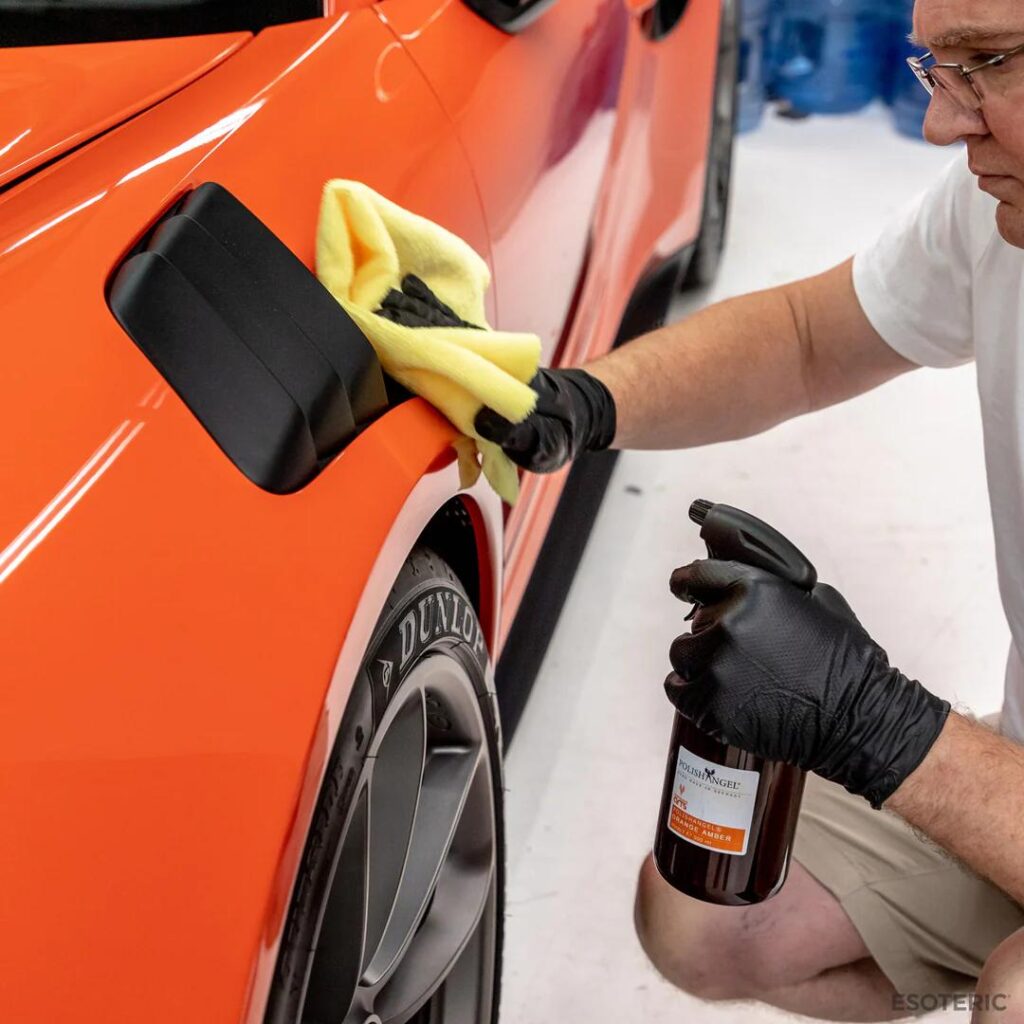As an Amazon Associate, I earn from qualifying purchases
Sticky, amber-colored tree sap clinging to your car’s surface can turn a beautiful paint job into an eyesore. Whether you’ve parked under pine trees, maples, or any other sap-producing tree, those stubborn droplets seem determined to make your vehicle their permanent home.
Tree sap removal might seem daunting, but with the right approach and tools, you can restore your car’s finish without causing damage. The key lies in understanding what you’re dealing with and choosing the appropriate removal method for your specific situation.

This comprehensive guide will walk you through proven techniques for removing tree sap, from gentle household solutions to specialized commercial products. You’ll also learn how to protect your car’s paint during the process and prevent future sap incidents. By following these methods, you can keep your vehicle looking pristine, even when parking under nature’s messiest trees.
Table of Contents
- 1 Why It’s Important to Remove Tree Sap from Your Car
- 2 How to Clean Tree Sap off Your Car (Step-by-Step)
- 3 Best Tools and Products for Tree Sap Removal
- 4 How to Protect Your Car’s Paint After Sap Removal
- 5 Prevention Strategies for Future Protection
- 6 Frequently Asked Questions About Clean Tree Sap off Your Car
- 7 Keep Your Car Sap-Free and Protected
Why It’s Important to Remove Tree Sap from Your Car
Tree sap poses more threats to your vehicle than just cosmetic concerns. Understanding these risks will motivate you to address sap spots promptly and properly.
Paint Damage and Staining
Fresh tree sap starts as a soft, sticky substance, but exposure to sunlight and heat transforms it into a hardened, resin-like coating. This hardened sap can bond permanently with your car’s clear coat, creating stains that become increasingly difficult to remove over time. Left untreated, sap can etch into the paint layers, requiring expensive professional restoration or repainting.
Heat Amplification Effects
Dark-colored sap absorbs heat from the sun, creating hot spots on your car’s surface. These concentrated heat areas can cause paint to fade, bubble, or even crack around the affected spots. The thermal expansion and contraction cycles can weaken the paint’s adhesion to the underlying surface.
Attraction of Dirt and Debris
Sticky sap acts like a magnet for dirt, dust, pollen, and other airborne particles. This accumulation creates unsightly patches that become harder to clean the longer they remain. The combination of sap and debris can create abrasive compounds that scratch your paint when you attempt to wipe them away.
Reduced Resale Value
Visible sap damage and staining significantly impact your vehicle’s appearance and market value. Potential buyers often view paint damage as a sign of poor maintenance, leading to lower offers or difficulty selling your car.
How to Clean Tree Sap off Your Car (Step-by-Step)
Success in sap removal depends on using the right technique for your specific situation. These methods range from gentle approaches for fresh sap to more intensive solutions for hardened deposits.
Method 1: Rubbing Alcohol Technique
Isopropyl alcohol effectively dissolves tree sap without harming most automotive paints. This method works best on fresh to moderately aged sap deposits.
Start by parking your car in a shaded area and ensuring the surface is cool to the touch. Apply a small amount of 70% or higher isopropyl alcohol to a clean microfiber cloth. Gently dab the sap-covered area, allowing the alcohol to penetrate for 30-60 seconds.
Use circular motions to work the alcohol into the sap, applying gentle pressure. The sap should begin to soften and lift away from the paint. For stubborn spots, reapply alcohol and let it sit longer before attempting removal. Once the sap dissolves, clean the area with soap and water, then dry thoroughly.
Method 2: Heat and Ice Approach
Temperature manipulation can make sap removal easier by either softening or hardening the substance for different removal techniques.
For the heat method, use a hair dryer on low heat to warm the sap until it becomes pliable. Once softened, use a plastic scraper or credit card to gently lift the sap away from the surface. Work slowly to avoid scratching the paint.
The ice method works by hardening the sap until it becomes brittle. Hold an ice cube wrapped in a cloth against the sap for several minutes. The hardened sap may crack or chip away more easily, allowing you to remove larger pieces without smearing.
Method 3: Commercial Sap Remover
Specialized automotive SAP removers offer the most reliable results for challenging cases. These products are formulated specifically for automotive finishes and typically provide superior dissolving power.
Follow the manufacturer’s instructions carefully, as application methods vary between products. Most require you to spray or apply the solution, allow it to penetrate for a specified time, then wipe away with a clean cloth. Always test the product on an inconspicuous area first to ensure compatibility with your car’s finish.
Method 4: Household Oil Solutions
Common household oils can effectively dissolve tree sap through their natural solvent properties. Cooking oil, olive oil, or even peanut butter contains oils that break down sap’s sticky compounds.
Apply a small amount of oil to the affected area and let it sit for 10-15 minutes. The oil will gradually penetrate and soften the sap. Use a soft cloth to gently work the area in circular motions. After removing the sap, wash the area thoroughly with dish soap to remove any oil residue, as oil can attract dirt if left on the surface.
Method 5: WD-40 Treatment
WD-40’s penetrating properties make it effective for loosening stubborn sap deposits. Spray a small amount directly onto the sap and allow it to penetrate for several minutes.
Use a soft cloth to wipe away the dissolved sap, working from the outside of the spot toward the center to prevent spreading. Clean the area with soap and water afterward to remove any WD-40 residue. This method works particularly well on older, hardened sap that resists other removal techniques.
Best Tools and Products for Tree Sap Removal
Having the right tools and products makes sap removal safer and more effective. Quality equipment protects your paint while maximizing your success rate.
Essential Cleaning Tools
Microfiber cloths are indispensable for sap removal because their fine fibers lift contaminants without scratching delicate paint surfaces. Keep several clean cloths on hand, as you’ll need fresh ones throughout the process.
Plastic scrapers or old credit cards help remove softened sap without damaging paint. Avoid metal scrapers, which can easily scratch or gouge automotive finishes. For precision work around emblems or trim, consider using plastic detailing picks.
Recommended Commercial Products
Turtle Wax Bug and Tar Remover effectively dissolves various automotive contaminants, including tree sap. Its gentle formula works on most paint types without causing damage.
Goo Gone Automotive specifically targets sticky residues and works well on both fresh and aged sap. The automotive formulation is designed to be safe for car finishes while providing strong dissolving power.
3M Adhesive Remover offers professional-grade performance for stubborn sap deposits. This product is commonly used by detailing professionals and provides excellent results on challenging cases.
Safety Equipment
Nitrile gloves protect your hands from chemicals and prevent skin oils from contaminating cleaned surfaces. They also provide a better grip when handling tools and products.
Safety glasses shield your eyes from splashing solvents, especially when using spray products. Even gentle household solutions can cause eye irritation if accidentally splashed.
How to Protect Your Car’s Paint After Sap Removal
Sap removal can strip away protective wax and potentially stress your car’s clear coat. Proper post-removal care ensures your paint remains protected and lustrous.
Immediate Post-Removal Care
Thoroughly wash the treated area with automotive soap to remove any residual cleaning products. Leftover solvents or oils can attract dirt or cause paint issues if not completely removed.
Inspect the area under good lighting to ensure all sap residue is gone. Sometimes multiple treatment cycles are necessary for complete removal. Address any remaining spots before proceeding to protection steps.
Paint Protection Application
Apply a coat of automotive wax or sealant to the cleaned area. These products create a barrier between your paint and environmental contaminants, making future sap removal easier.
For best results, wax the entire panel or section rather than just the spot-treated area. This ensures uniform protection and appearance. Quality carnauba wax provides excellent protection and enhances paint depth and shine.
Regular Maintenance Schedule
Establish a regular washing and waxing routine to maintain your car’s protective barriers. Monthly washing removes fresh contaminants before they can bond permanently with your paint.
Quarterly wax applications ensure consistent protection against tree sap, bird droppings, and other environmental hazards. Regular maintenance makes any future sap removal much easier and less likely to cause paint damage.
Professional Paint Correction
For severe sap damage or etching, consider professional paint correction services. Professional detailers have specialized compounds and equipment to remove deep stains and restore paint clarity.
Paint correction involves multiple steps of polishing with progressively finer abrasives to remove surface imperfections. This process can eliminate sap stains that home methods cannot address.
Prevention Strategies for Future Protection
Preventing sap contact is more effective than removal. These strategies help minimize your exposure to tree sap while maintaining your vehicle’s appearance.
Strategic Parking Choices
Avoid parking directly under trees, especially during spring and summer when sap production peaks. Even trees that don’t typically produce visible sap can release sticky substances during certain weather conditions or seasons.
Look for covered parking options when available, such as garages, carports, or parking structures. These locations provide complete protection from falling sap, bird droppings, and other environmental contaminants.
Protective Barriers
Car covers provide excellent protection when parking outdoors for extended periods. Choose breathable materials that allow moisture to escape while blocking falling debris.
For temporary protection, consider using a large tarp or drop cloth when parking under trees for short periods. While not as convenient as a fitted cover, these options provide effective barrier protection.
Regular Inspection and Quick Action
Inspect your car regularly for fresh sap deposits, especially after parking under trees. Fresh sap removes much more easily than aged deposits, often requiring only soap and water.
Keep basic sap removal supplies in your car for immediate treatment of fresh deposits. A small bottle of rubbing alcohol and a microfiber cloth can prevent minor sap spots from becoming major problems.
Frequently Asked Questions About Clean Tree Sap off Your Car
Can tree sap damage your car’s paint?
Yes, tree sap can cause significant paint damage if left untreated. Fresh sap is relatively harmless, but as it hardens and bonds with your clear coat, it can create permanent stains and etching. The longer sap remains on your car, especially when exposed to heat and UV rays, the more likely it is to cause lasting damage that requires professional correction or repainting.
Is it safe to use rubbing alcohol to remove tree sap?
Rubbing alcohol is generally safe for automotive paint when used properly. Use isopropyl alcohol with a concentration of 70% or higher, and always test it on an inconspicuous area first. Apply it with a soft microfiber cloth and work gently to avoid damaging the clear coat. After removal, wash the area with soap and water to remove any alcohol residue.
Can I remove tree sap with household items?
Many common household items effectively remove tree sap. Cooking oils, peanut butter, ice cubes, and hair dryers can all help with sap removal. However, specialized automotive products typically provide better results with less risk of paint damage. If using household items, always clean the area thoroughly afterward and apply wax for protection.
How do I prevent tree sap from sticking to my car?
Prevention strategies include avoiding parking under trees, using car covers, and maintaining a good coat of wax on your vehicle. Regular waxing creates a barrier that makes sap removal easier and prevents bonding with your paint. When parking under trees is unavoidable, inspect your car regularly and remove fresh sap immediately before it hardens.
How often should I clean my car if I park under trees?
If you regularly park under trees, inspect your car weekly, and wash it at least every two weeks. During peak sap season (typically spring and early summer), you may need to check daily and clean immediately when sap is discovered. The frequency depends on the types of trees, weather conditions, and how much protection your car has from wax or sealants.
Keep Your Car Sap-Free and Protected
Tree sap removal doesn’t have to be a nightmare when you know the right techniques and have the proper tools. Start with gentle methods like rubbing alcohol or household oils for fresh sap, and escalate to commercial products only when necessary. Remember that prompt action prevents most serious damage and makes removal much easier.
The key to long-term success lies in combining effective removal techniques with preventive measures. Regular waxing, strategic parking choices, and quick response to fresh sap deposits will keep your car looking its best. When removal does become necessary, always follow up with proper paint protection to prevent future problems.
For severe sap damage or if you’re uncomfortable performing the removal yourself, don’t hesitate to consult a professional detailer. The cost of professional service is often less than repairing paint damage caused by improper removal attempts.
As an Amazon Associate, I earn from qualifying purchases


